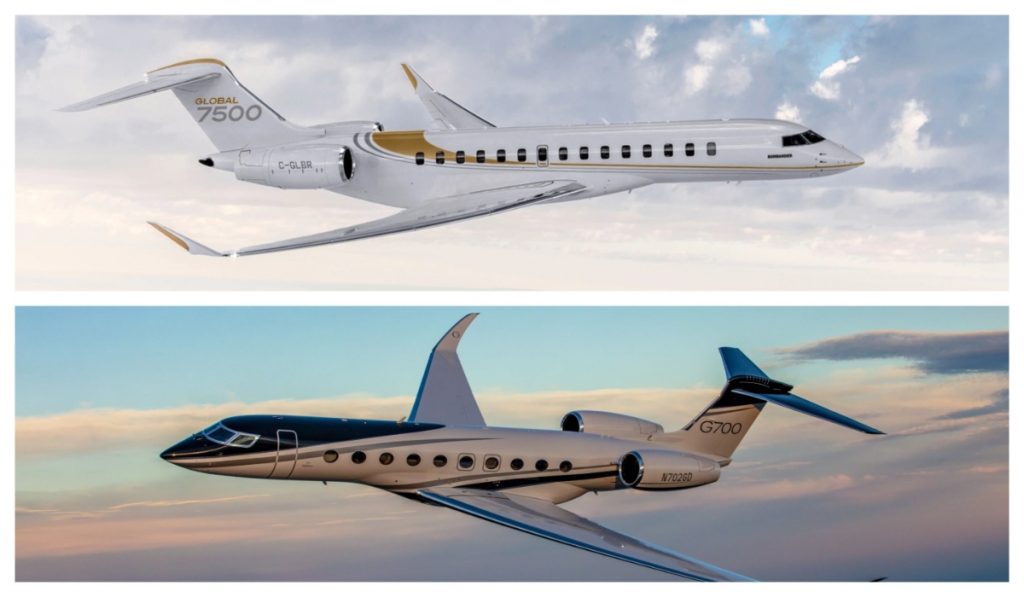Comparing the Bombardier Global 7500 and the Gulfstream G700 Ultra-Long-Range Business Jets
The Bombardier Global 7500 and Gulfstream G700 stand out as the flagship ultra-long-range business jets, designed to deliver unmatched performance, luxurious comfort, and cutting-edge technology.

From an operational standpoint, both the Global 7500 and G700 offer remarkable efficiency in terms of fuel consumption and runway performance, allowing them to access a wide range of airports globally.
Their ability to operate from both major international hubs and smaller regional airports provides significant flexibility to charter operators and private jet owners alike.
The introduction of these aircraft has set new benchmarks in the industry, driving a wave of innovation and raising customer expectations for ultra-long-range private travel.
Both aircraft push the boundaries of what is possible in private jet travel, catering to high-net-worth individuals and corporate travelers who demand excellence on every flight.
Let’s take a look at the differences between the Global 7500 and Gulfstream G700.
Performance and Range
| Specifications | Global 7500 | Gulfstream G700 |
|---|---|---|
| Cruise Speed | Mach 0.85 | Mach 0.85 – 0.90 |
| Top Speed | Mach 0.925 | Mach 0.925 |
| Range | 7,700 nmi | 7,500 nm |
The Bombardier Global 7500 is renowned for its record-breaking range, boasting the ability to fly up to 7,700 nautical miles non-stop at impressive cruise speeds nearing Mach 0.925.
Its advanced aerodynamics and powerful engines not only allow it to traverse vast distances with ease but also ensure high-speed travel on long-haul routes.
The Gulfstream G700 offers a similarly impressive range of approximately 7,500 nautical miles, paired with a state-of-the-art design that supports efficient, high-speed cruising.
The G700 matches the 7500 in terms of cruising speed and maximum speed.
Both jets are engineered to provide non-stop transcontinental and intercontinental flights, ensuring passengers reach their destinations quickly and comfortably.
Cabin Comfort and Layout
| Cabin Dimensions | Global 7500 | Gulfstream G700 |
|---|---|---|
| Height | 6 ft 2 in | 6 ft 3 in |
| Width | 8 ft 0 in | 8 ft 2 in |
| Length | 54 ft 5 in | 56 ft 11 in |
The Global 7500 features a truly innovative cabin layout, divided into four distinct living spaces.
Passengers enjoy a main cabin, a forward club, a separate stateroom, and a dedicated crew suite, along with large panoramic windows that flood the cabin with natural light.
The cabin’s design is intended to maximize space and privacy, ensuring a serene in-flight experience.
The Gulfstream G700, meanwhile, sets new standards with an expansive, flexible cabin that can be configured to suit various travel needs.
Its cabin is engineered for low altitude, maintaining a comfortable cabin pressure equivalent to an altitude of just 4,850 feet, which reduces passenger fatigue on long flights.
The G700’s interior is characterized by its spacious seating, advanced cabin management systems, and customizable layouts that can include conference areas, lounges, and private staterooms, providing an environment that is both functional and indulgent.
Avionics and Technology
Both jets are equipped with state-of-the-art avionics that enhance flight safety, operational efficiency, and passenger experience.
The Bombardier Global 7500 is outfitted with an advanced flight deck featuring integrated displays and sophisticated flight management systems that streamline operations and offer pilots enhanced situational awareness.
Its connectivity solutions ensure that passengers remain productive and entertained throughout their journey.
The Gulfstream G700 integrates Gulfstream’s renowned Symmetry Flight Deck, which offers intuitive controls, high-resolution displays, and innovative automation features that simplify pilot workload.
The G700’s advanced cabin connectivity and entertainment systems are designed to keep passengers connected, whether they’re conducting business or simply relaxing during long flights.
Operational and Charter Costs
The Bombardier Global 7500 and the Gulfstream G700 are both top-tier business jets, each with distinct financial considerations.
The Global 7500 is priced at approximately $75 million, with customizations that can take the cost to $81 million or more. Pre-owned Global 7500s can cost between $55 million and $65 million.
The G700 comes in at around $79 million, with customizations that can bring the final cost up to $85-$95 million.
In terms of operating expenses, the Global 7500 incurs variable costs of about $3,178 per hour, which is approximately 14.8% lower than the G700’s $3,638 per hour.
When it comes to chartering, the Global 7500 commands an estimated hourly rate of $18,000*, reflecting its advanced features and performance capabilities – specific charter costs for the G700 are not readily available, but are expected to be comparable given the aircraft’s similar market positioning.
Summary
In comparing the Bombardier Global 7500 and the Gulfstream G700, it becomes clear that both aircraft embody the pinnacle of private jet engineering, blending extraordinary range, speed, and luxurious comfort with advanced technology and operational versatility.
While the Global 7500 excels with its high-speed perfromance and superior range, the Gulfstream G700 matches this performance while offering a slightly larger cabin.
Ultimately, the choice between these two titans of private aviation will depend on individual preferences, specific mission requirements, and the desired balance between performance and cabin luxury.
* Hourly charter rates displayed are based on market averages, and will vary based on a variety of factors ranging from year, makes and model of aircraft; routing, scheduling/availability, fuel prices and more, and do not include ramp, hangar, FBO, overnights, daily minimums, taxes, international fees, catering, ground transportation, or de-icing.

